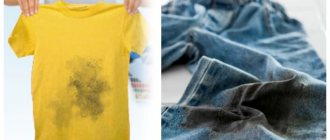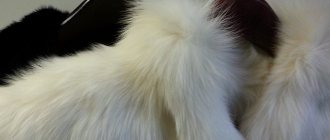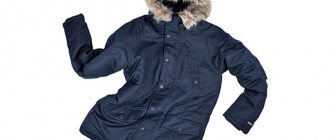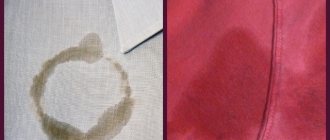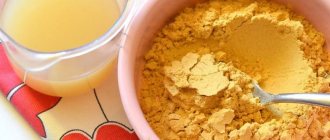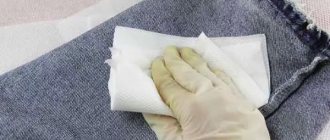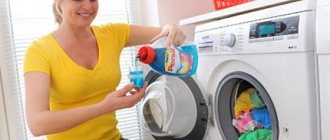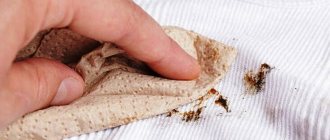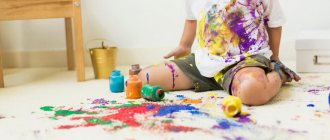Reasons for the appearance of different types of pollution
Let's look at what kind of stains a bathroom curtain is susceptible to and find out the reasons for their occurrence in order to prevent their occurrence in the future:
- Yellowness. It appears at the bottom of the curtain, from contact with soapy water or foam. To prevent yellowing from appearing, after taking a shower or bath, rinse the curtain with clean water and dry thoroughly.
- White stains. The content of calcium and magnesium salts makes the water increased hardness. This is what causes white marks to form after water droplets dry.
- Rust. Red stains are difficult to remove; they can be removed while they are fresh. Most often, rust stains appear on the bottom of the curtain, as it is constantly in contact with water.
- Mold. Favorable conditions for their appearance and reproduction are high humidity and a warm environment. Most often, fungus can be found in the folds of the shower curtain. Keeping your bathroom well ventilated and removing moisture from the surface of the curtain will help prevent mold from forming.
How often to clean a curtain
A bathroom curtain, especially if it is made of thin material (for example, polyethylene), does not require constant maintenance. On the contrary, you only need to clean it when necessary. Frequent washing can deform the fabric, and careless movement risks tearing the material. Therefore, it is more advisable to apply preventive measures and begin the cleansing process when there is visible contamination.
We hope that these tips and videos on how to wash a bathroom curtain without dry cleaning will help you save a lot of time and money.
What cleaning and washing products to use
To remove various types of stains, specialized solutions are used:
- Domestos;
- Vanish;
- Sanita;
- Comet.
- as well as household products used in traditional washing methods, which include: baking soda, acetic and citric acids.
Which cleaning product to use depends on the material of the curtain. When choosing curtains for the bathroom, you need to remember that they differ not only in size and design, but also in the material used. Shower curtains can be textile or plastic.
Main types:
Polyethylene
This type of material is thin and short-lived. It is not customary to wash it. Typically, film curtains are replaced every six months with new ones, since they have a low price.
But in case of urgent need, plastic curtains should be carefully and carefully cleaned with a mild detergent. Washing powder or dishwashing detergent is suitable for this.
Polyester
The most popular and practical material that can be washed both by hand and in a washing machine at temperatures up to 40 degrees. When washing, you can add bleach, powder, vinegar, soda and citric acid.
Textile curtains
Fabric curtains are made of synthetic and natural material, which is impregnated with a moisture-repellent composition.
The fabric requires scrupulous attention. Usually have care information on the product label. They can be washed in a machine at 30 degrees on a delicate cycle.
If the fabric is cotton or linen, then it is permissible to boil it with the addition of boric acid. For hand and machine washing, use powder and fabric softener.
Polyvinyl chloride
Vinyl is attractive due to its low cost and ease of maintenance. They do not absorb moisture at all; just wipe the curtain with a dry cloth after taking a shower.
Baking soda, lemon juice, bleach and any type of cleaning powder are suitable for removing stains.
How to clean without removing?
In order for the curtain in the bathroom to retain its presentable appearance longer and serve for a long time, it must not only be washed periodically, but also regularly looked after between washes.
For this processing you will need:
- spray bottle;
- sponge;
- detergent dissolved in water.
For processing, it is advisable to use a detergent in gel form.
Procedure:
- Dilute detergent in water.
- Pour it into a spray bottle.
- Spray the cleaner over the surface of the curtain.
- Wipe the material with a sponge.
- Wash off the detergent composition using a sponge or rag.
Such treatment, without removing the curtain, will not replace a full wash, but will help maintain the hygiene of the curtain. And it will not allow the formation of difficult-to-remove contaminants.
There are three ways to wash a bathroom curtain
Partial wash
It is not necessary to wash the entire curtain, especially when the dirt is at the bottom of the curtain. Stains can be removed with a brush and some detergent.
If the stains cannot be removed, you can take a handful of baking soda, apply it to a sponge and rub thoroughly. Next, rinse the bottom part with clean water.
Handwash
It will not be difficult to remove various types of stains manually. In a basin with a warm solution in a ratio of 3 liters of water to 1 tsp. soda and 1/2 tsp. Soak the curtain with citric acid for 60 minutes.
After time, wash by hand and rinse thoroughly in clean water. If the curtain is heavily soiled, you should repeat the soaking procedure with a new solution, rub the dirt with a brush, and only then proceed to rinsing and drying.
For delicate hand washing, you can use baby laundry bleach and a few drops of tea tree essential oil. This method will gently remove stains, disinfect the product and leave a pleasant smell.
IMPORTANT! It is strictly forbidden to wash shower curtains in boiling water; under the influence of high temperatures, the curtains can become deformed.
Machine washable
When washing your bath curtain in the washing machine, follow these guidelines:
- The washing mode is selected depending on the symbols indicated on the label. If there is no tag, delicate wash is more suitable.
- It is better not to exceed the temperature at which the curtain can be washed by more than 30 degrees.
- If the product allows, then you need to add chlorine powder.
- Set the additional rinse, but do not use the spin and dry mode.
- For more efficient washing, terry towels are additionally loaded into the drum of the machine; they act as brushes.
- Before using the washing machine, if stains are difficult to remove, you should use a pre-wash. Depending on the nature of the traces, choose a recipe for removing contaminants.
IMPORTANT! You cannot wring out the bathroom curtains, otherwise creases and bruises will appear on it. Under no circumstances is it recommended to iron the product.
How to wash curtains
The most effective way to clean bathroom curtains is by washing them. Products made of polyvinyl chloride and polyester are best washed.
It is recommended to wash the curtain in an automatic machine, turning on the “delicate wash” program at a temperature of 40°.
If it is allowed to use bleach, then the available detergent is poured into the detergent compartment, for example, Belizna, Domestos or any other.
If the use of chlorine is prohibited, it is correct to soak the curtain with Vanish or any other non-chlorine product before washing.
If the dirt is heavily soiled, you can turn on the “spot” mode. Under no circumstances should the product be dried or wrung out in a machine.
For the best effect, you need to throw a couple of old towels into the machine with the curtain at the same time: they will play the role of a brush during washing.
The following methods can be used:
- Pour 120 ml of vinegar into the detergent compartment, the same amount of water, 2 tbsp. l. soda, 25 drops of pine oil. Wash the curtain on the gentle cycle.
- Use half a glass of apple cider vinegar and 60 ml of liquid bleach on the “delicate” cycle in cold water. It is advisable to dry it in the sun.
If you need to wash the curtain in an activator-type machine, you should first soak it in warm water with laundry soap or bleach for 2 hours. Then scrub the dirty areas with a brush and wash in warm water.
Experienced housewives advise that instead of powder, in this case, throw a few handfuls of soda into the car, and then rinse the product: first in a vinegar solution (2 tablespoons per 1 liter of water), and then in clean water.
General recommendations for any type of washing:
- After washing, soak the curtain in a salt solution for half an hour, then let the water drain and immediately hang it in place. At the same time, a protective film is created on the surface of the curtain, which will protect it from rapid contamination.
- Do not squeeze.
- Turn on the “delicate wash” mode with a temperature no higher than 40°. Sometimes the label may indicate a maximum allowed temperature of 30°.
- Wash with regular powder, with the addition of bleach.
By the way, before washing it is recommended to remove the rings from the curtains or wash them in a special laundry bag.
Handwash
First, the curtain should be soaked in warm water with bleach. Add stain remover and soda to the washing water. Wipe particularly dirty areas with a brush using the following mixture: a glass of baking soda and half a glass of warm water.
After this, you need to rinse, add 3 packs of citric acid to the rinse water. Then place the curtain in a solution of 5 tablespoons of salt per 1 liter of cold water. After half an hour, remove and hang.
Curtain care
To protect the curtain in the bathroom from mold, mildew and other contaminants, you need to do the following once every two weeks (or once a month):
- Clean it with any bathroom and kitchen cleaner. To do this, the product should be diluted in half with water, poured into a spray bottle, sprayed on the curtain and wiped with a sponge. Then rinse with clean water.
- Dilute 100 g of soda in 0.5 liters of hot water, spray and clean with a sponge.
These methods are good if the curtain is not very dirty. With regular use of these methods, you can protect the curtain from stains and dirt.
How to remove yellowness from a bathroom curtain
The basic means at hand that will rid the curtain of yellowness are available in almost every home.
Use of whiteness
When machine washing, white is added to the bleach compartment in an amount of 100 ml and washed on a long cycle with pre-soaking.
If the product manufacturer prohibits the use of chemical bleaches containing chlorine, then there is an alternative - oxygen bleaches.
Such products include “Vanish”; they are also added to the bleach compartment during washing, following the instructions presented on the product’s packaging. If it is heavily soiled, you can leave the product overnight in a bowl of diluted product.
Traditional methods
The folk method of eliminating yellow plaque consists of several stages:
- Wipe the surface with a sponge soaked in hydrogen peroxide.
- After this, the curtain should be dipped in a mixture of 500 ml of warm water and 200 ml of vinegar.
- Finally, rinse in cool water.
An equally effective recipe is ammonia and table salt. Ammonia neutralizes magnesium salts, which give a yellow tint to things.
Take 250 ml of water, 1 tsp. ammonia and 1 tsp. l. salt is stirred until the salt is completely dissolved. Dip the dirty section of the curtain into the liquid and leave it for an hour. After which the item must be washed and rinsed by hand.
Another way is to add a couple of teaspoons of boric acid to warm water. Leave the curtain to soak for 5 hours, then wash using any acceptable method.
How to clean a curtain
What products can be used for washing and cleaning
To remove different types of stains, it is worth using special solutions that were created specifically for this purpose:
- Vanish.
- Domestos.
- Comet.
- Sanita.
- Other household products that are used for traditional washing methods include baking soda, citric and acetic acid.
Which type of product to use will depend on what material the curtain is made of. When choosing curtains for bathrooms, you should remember that they differ from each other not only in design and size, but also in the material they are made of. Shower curtains can be either plastic or textile. Below are the main varieties that will help you figure out how to remove mold from a bathroom curtain.
This type of material is quite thin, which is why it is short-lived. It is usually not washed. Since such curtains, made from ordinary film, are replaced with new ones every 6 months, there is no need to wash it, moreover, the products are low in cost. But if you really need to, you can very carefully and carefully clean the surface using a dishwashing sponge and a non-aggressive chemical. You can use dishwashing detergent or washing powder.
Plastic.- Polyester. This is the most popular and also the most practical material that can be washed, both by hand and in a washing machine, but the temperature should not be higher than 40 degrees. When washing, it is allowed to use washing powder, bleach, soda, vinegar and citric acid.
- Textile curtains. Fabric curtains are usually made from a mixture of natural and synthetic material, which during manufacturing is impregnated with a special composition that can repel water. Fabric requires careful attention when choosing. Typically, all care information is indicated on the product label. You can even wash such curtains in a washing machine, but only on a delicate cycle and at a temperature not exceeding 30 degrees. If the fabric is linen or cotton, then it is possible to boil it in water to which boric acid will be added. When washing by machine or by hand, it is better to use washing powder/gel and fabric softener to eliminate any remaining unpleasant odors.
- Polyvinyl chloride. Vinyl products are attractive because they are inexpensive and easy to care for. They are not able to absorb moisture at all; it will be enough to wipe the curtain with a dry cloth after swimming or taking a shower. To remove dirt from such a curtain, use baking soda, cleaning powders (any kind), bleach and lemon juice.
Let's look at three ways to clean curtains.
TOP 3 effective ways to clean curtains
Local cleansing
It is not necessary to wash the entire curtain, especially if the dirt is located at the bottom of the curtain. You can remove stains using a regular brush and detergent that is suitable for your type of curtain. If for some reason the stains cannot be washed off, then take a handful of baking soda, apply it to a dishwashing sponge (the rough side) and scrub the item thoroughly. Then all that remains is to rinse everything with clean water and wipe (or hang to dry).
Handwash
To manually remove various stains, add 1 tsp to a bowl of warm water per 3 liters of water. baking soda and ½ tsp. citric acid, and then soak everything for 1 hour. Agree, nothing complicated. When the allotted time is up, wash everything with your hands and rinse thoroughly in clean water. If the curtain was heavily soiled, then you should repeat the procedure with soaking, but now in a new solution and reheated water, then rub all dirty places with a brush, and only after that you can start re-rinsing and drying. For delicate hand washing, you can use baby laundry bleach and a little essential oil for a pleasant smell that will cover up the mildew odors. This method will help to gently remove stains, disinfect the product and leave only cleanliness and a pleasant aroma.
Please note that washing bathroom shower curtains to remove mold and other contaminants in hot water is strictly prohibited, as the curtains may begin to deform due to exposure to high water temperatures.
Machine washable
In order to wash bathroom curtains and clean them of mold, mildew and rust, follow a number of recommendations:
- The washing mode should be selected depending on the symbols indicated on the product label. If there is no tag, it is better not to take risks and set the washing cycle to a delicate cycle and a temperature no higher than 30 degrees.
- The temperature should not be more than 30 degrees, although for some products it is permissible to use all 40 degrees.
- If allowed, add laundry detergent containing chlorine.
- Set the extra rinse mode, but do not use the spin and dry mode.
- In order to increase the efficiency of washing, you should additionally throw terry towels into the drum of the washing machine, which will act as brushes for soft and gentle cleaning.
- Before you machine wash, use an extra wash for stubborn stains. Depending on the type of contamination, select different recipes to remove unwanted stains.
Important! Bathroom curtains should never be wrung out, as they may become wrinkled and wrinkled. Also, under no circumstances should you iron the product, even if it is textile.
How to remove yellowness from a curtain
In order to rid the curtain of unsightly yellowness, every home has available means, and you probably have them too.
White
So, for machine washing, you should add white (about 100 ml) to the powder receptacle, and then set it to a long wash cycle with pre-soaking. If the manufacturer of the product indicated on the label that under no circumstances should you use bleaches that contain chlorine, then there is an alternative - oxygen bleaching agents. These include the popular “Vanish” product, which should also be added to the powder receptacle in the amount recommended in the product’s instructions. If the stains are strong, leave the product overnight in a bowl with diluted bleaching solution.
Folk methods of struggle
The familiar folk method of eliminating yellow plaque consists of the following steps:
- Wipe the surface with a dishwashing sponge, which should be moistened with hydrogen peroxide.
- Next, dip the mixture into a solution containing 200 ml of vinegar for every ½ liter of heated water.
- Finally, rinse the curtain in cold water.
An equally effective way to combat mold on a bathroom curtain is to use ammonia and table salt. Ammonia will neutralize the magnesium salts that cause shower products to turn yellow. To do this you will need to take 250 ml of water, 1 tsp. salt and 1 tsp. ammonia, and then mix everything until the salt is completely dissolved. Dip the dirty section of the curtain into the liquid and leave for about 1 hour. After this, wash the curtain as usual and rinse by hand. And the last popular method is to add 2 tablespoons of boric acid to warm water. Leave the curtain to soak for 5-6 hours, and then you need to wash the curtain in any way convenient for you.
Removing rust stains
Recipe No. 1
To remove fresh rust stains, use a mixture of ammonia and hydrogen peroxide, the first substance should be 3 measures, the second 1. The resulting solution should be applied with a brush, left for a couple of minutes, and then rubbed well. If you can’t remove the rust, you should take a cotton pad, soak it in the solution and apply it to the stain, and then leave it for 15-20 minutes. Next, hand wash the curtain.
Recipe No. 2
There is a second way to fight rust, and for it you should take 1 tsp. acetic acid, and then add to a glass of water. Next, the liquid needs to be heated, but not brought to a boil, removed from the heat and added a little ammonia and ½ tsp. baking soda. Dip the part of the curtain that is affected by rust into this mixture. If the destruction of the red spot did not work the first time, then repeat the procedure. To remove rust, use chemicals such as Sanita or Adrilan." Treat the stains with the substance and leave for a couple of minutes, and then remove everything with wet wipes. Please note that when removing chemical stains, it is better to use rubber gloves.
How to wash curtains from fungus and mold
Fungi are very susceptible to alkaline and acidic environments, so to destroy it it is better to use soda and vinegar, as well as lemon juice or acid.
To remove mold from a bathroom curtain, use this method:
- Place the curtain in a basin and rinse in warm water.
- Next, you need to pour baking soda onto the stains where there is fungus and scrub it all with a brush or dishwashing sponge.
- When all dirt has been removed, rinse the curtain in a large amount of heated water, in which a bag of citric acid has been previously dissolved.
There is also another effective method for removing fungus from curtains. To do this, add 100 grams of soda and 100 ml of vinegar to the drum of the washing machine, do not forget to additionally turn on the pre-wash mode. Another method is bleach, which will be added to a bowl of water (1-2 caps). The product should lie in such a solution for at least 1 hour, and then scrub the stains with a brush, rinse in plenty of water and dry.
Removing limescale
When dealing with limescale deposits, the ideal assistant is bleach, which contains chlorine. The curtain needs to be soaked in warm water, and 50 ml of bleaching agent is poured into it and left for half an hour. Next, you should wash everything, either by hand or in a washing machine. When rinsing, be sure to add fabric softener to remove odors and soften the water.
Features of cleaning curtains made of polyvinyl chloride (PVC)
Vinyl curtains are easy to maintain. There is only one peculiarity in caring for such products - they cannot be washed either by hand or in a machine. Such curtains can only be washed, and to do this, use a dishwashing sponge soaked in a soapy solution. If there are white spots, mold or rust on the curtains, use bleach, cleaning powders like Comet, or gel products like Sif to remove them. The product must be applied to the product with a sponge and left for 5-7 minutes so that it has time to act, and then thoroughly rinse everything off with water and wipe with a dry cloth. Among the traditional methods of caring for vinyl curtains, use ammonia, baking soda and citric acid.
How to dry a bathroom curtain
The curtain should not be dried or wrung out in washing machines, as this may damage the appearance of the product. It will be much better if you squeeze it out slightly with your hands and let the remaining water drain over the bathtub. Next, we hang the product so that there are no wrinkles in the fresh air (street or balcony with open shutters) until it dries completely. If it is not possible to dry the curtain on the balcony, hang it on the curtain rod, and then wipe it with a dry cloth and leave the door to the bathroom open so that there is air access.
Please note that drying curtains near heating appliances sometimes results in yellow stains.
Removing rust stains
Recipe No. 1
You can wipe off fresh rust stains with a mixture of ammonia and hydrogen peroxide in a ratio of 3 to 1.
The solution is applied with a brush, left for 2-3 minutes, then scrubbed off. If the rust is not removed, then a cotton pad soaked in the solution is applied to the stain and left to act for 15 minutes. The curtain is then washed by hand.
Recipe No. 2
A teaspoon of acetic acid per glass of water, then heat the liquid without bringing to a boil, remove from heat and add a couple of drops of ammonia and half a teaspoon of soda.
The item affected by rust is dipped into the resulting mixture. If the destruction of the red spot does not occur the first time, the procedure is repeated.
To remove rust, chemical compositions of the well-known “Sanita” are used.
Treat the stain with the substance and leave for a few minutes, remove with a damp cloth. When removing chemical stains, it is recommended to use gloves.
How to use the “Whiteness” product
Light curtains are difficult to wash from stains, since the slightest stains and stains are visible on white things. In this case, use the “Whiteness” product, which helps solve several problems:
- Maintain a fresh and neat appearance. To do this, fill a bowl with cool water and add 2 tbsp. l. cleaning agent. The curtain is soaked for 20 minutes and then rinsed. If necessary, it can be washed by hand or in a machine.
- Remove stains, grayness and yellowness. 2 large spoons of “Whiteness” are added to 10 liters of water, after which the curtain is soaked for 1 hour.
- Bleaching even thick fabric. “Whiteness” is applied to problem areas of the curtain, but should not be left on for more than 1 minute. Next, the item is soaked and washed.
Attention! Frequent use of chlorine-containing bleaches is dangerous for the product, as there is a risk of damage to the fibers. It is recommended to replace aggressive chemicals with safer products. However, they usually have another drawback - high price.
We recommend:
How to wash angora
How to wash a bathroom curtain from mold and mildew
The fungus is afraid of alkaline and acidic environments and soda, vinegar, and lemon juice are used to destroy it.
The following method will help remove mold from bathroom curtains:
- Place the curtain in a basin and rinse in warm water.
- Sprinkle baking soda on the fungus stains and rub the moldy areas with a brush or sponge.
- Rinse in plenty of warm water with a packet of citric acid added.
Let's say there is another way to wash the curtain from the fungus. Add 100 grams of baking soda and vinegar each to the machine drum, and additionally turn on the pre-wash mode.
A good way to clean curtains is to use bleach. Add a couple of caps of bleach to a bowl of water.
The product is left in this solution for an hour, then the stains are scrubbed off with a brush, followed by rinsing and drying.
Methods for removing limescale
Frequent contact of curtain material with hard water can lead to limescale stains. This formation spoils the appearance and reduces the service life of the curtain.
Lemon acid
For processing you will need:
- citric acid (1 small bag);
- water;
- pelvis;
- brush.
Progress:
- Pour 2 liters of water into a basin.
- Dissolve citric acid in water.
- Soak stained areas for 60 minutes.
- Brush over lime stains.
- Rinse the product.
In order to eliminate lime stains, it is not necessary to treat the entire surface with the selected product. It is quite enough to clean only the stains, and then simply wash the product in the usual way.
Vinegar
Yellow deposits on the material can be removed with table vinegar. For processing you will need:
- pelvis;
- vinegar;
- tablespoon;
- water;
- brush.
Processing includes the following steps:
- Pour water (2 liters) into a basin.
- Measure vinegar (3 tablespoons) into water.
- Soak areas affected by lime deposits (or the entire curtain) in a basin.
- Leave for 60 minutes.
- Scrub stains with a brush.
- Rinse.
- Hang.
Vanish
Traces of water drops that have dried on the curtain are not aesthetically pleasing and require timely removal. In addition to homemade recipes, household chemicals designed to remove difficult stains will come to the rescue. Examples of such drugs are Vanish and Ace.
The selected product is used according to the instructions indicated on the package. Rub stains with a sponge. After treatment, rinse and wash in the usual way, adding Vanish to the detergent.
Features of washing polyvinyl chloride curtains
Vinyl curtains are easy to maintain. The peculiarity of washing curtains made of polyvinyl chloride is that they do not require machine or hand washing.
You can wash vinyl curtains with a sponge dipped in soapy water. If white spots, rust or mold appear on the curtains, then to remove them you will need bleach, Comet cleaning powder or Sif gel.
Apply the product to the product using a sponge and leave for 5 minutes to act, then rinse thoroughly with warm water and wipe with a dry cloth. Folk remedies you can use are baking soda, citric acid, and ammonia.
Types of curtains for the bathroom and their advantages
There are several options for shower curtains, differing in their properties and methods of caring for them.
Polyethylene curtains are the most economical in price, but at the same time the most short-lived in quality. They absorb dirt too quickly, are very difficult to clean, and therefore do not last long. In a relatively short time they crack, turn yellow or darken, and lose their original shape. Their only advantage is that the price allows you to frequently change these curtains, constantly updating the bathroom interior.
Products made from polyvinyl chloride or polyvinyl acetate are more durable and wear-resistant, easy to clean and wash. How to clean a vinyl bathroom curtain from mold will be discussed below.
Textile curtains with water-repellent impregnation are environmentally friendly, easy to care for, and are not afraid of moisture.
Note: an important quality for a good curtain will be antibacterial impregnation, which will prevent the appearance of fungus and help extend its service life.
Let's look at a few techniques on how to remove mold from a bathroom curtain.
How to dry a bath curtain
You cannot dry the curtain or spin it in the washing machine, as this will damage its appearance. It would be more correct to slightly squeeze the curtain with your hands and allow the remaining water to drain into the bathroom.
Next, you should hang the product, avoiding folds, in the fresh air until completely dry. If there is no possibility of drying on the balcony, then you can immediately hang the curtain on the curtain rod, then wipe it with a dry cloth and leave the door to the bathroom open to provide air access.
IMPORTANT! Drying curtains near heating appliances can lead to yellow stains.
Using the washing machine
This method is suitable for textile or vinyl curtains. If they are quite dirty, you can pre-soak them in a solution of washing powder or bleach. Then lightly scrub the mold stains with a brush or sponge. Typically, the manufacturer indicates the washing method and detergents on textile curtains. By following these recommendations, you will be able to achieve better cleaning without damaging the fabric. For example, the use of chlorine-containing products may be contraindicated. In this case, oxygen bleach is used. Washing usually needs to be done on a delicate cycle, not exceeding 40°C. After washing, the curtains are not wrung out, but straightened, allowing the water to drain. If folds remain, moisture will remain there and mold stains can form much faster in the future. Some people recommend using antifungal agents by adding them to water and soaking the curtains there. But you should carefully read the instructions and carry out a preliminary check on a small part of the curtain. It is also recommended to rinse them in salted water after washing, which helps them stay clean longer.
Tags: bathroom, machine, clean
Preventing problems
Specialized products to prevent shower curtain stains are essential. For example, water-repellent agents will help prevent the appearance of limescale, and an antimicrobial spray will prevent the formation of fungal spores.
After taking a bath or shower, the curtain must be wiped dry, avoiding any remaining moisture in the folds.
Leave the room open to allow the damp environment to ventilate. For weekly care, you should use a spray bottle and a specially prepared solution.
To do this, take 200 ml of water, 50 ml of table vinegar and 5 drops of pine essential oil. Spray the mixture onto the curtains and wipe with a sponge.
Once a month, the curtain is washed completely by hand or in a washing machine. The main condition will be proper care of the curtain and then it will retain its appearance for a long time.
Are there any restrictions for washing curtains?
Improper washing of bathroom curtains can lead to damage and loss of presentable appearance.
The cleaning method directly depends on the material the curtain is made of.
The most common include:
- polyvinyl chloride;
- polyester;
- polyethylene.
PVC and polyester
Vinyl and polyester for the most part are able to survive washing and maintain their appearance and performance . Restrictions on cleaning may be given by the manufacturer of a particular product, so you should read the label on the product before washing.
The manufacturer may prohibit machine washing, as well as the use of bleaches. In this case, it is better not to experiment and treat the curtains with your hands with an approved detergent.
If there are no strict restrictions, then automatic washing in a washing machine will be the best option. The exception is the need to remove stains characteristic of the bathroom: from rust, mold or limescale. Household chemicals and homemade recipes are used for these purposes.
Polyethylene
Among all the types of materials that are traditionally used to organize curtains in the bathroom, polyethylene is the cheapest and most fragile.
It is capable of good protection against splashing, but has a very short service life - up to six months.
Such material will not survive thorough washing . Maximum cleaning is a careful treatment with a non-aggressive agent. For example, Pemolux.
Cleaning is carried out with a soft sponge, without using brushes, which can damage the thin material. In case of serious contamination, the plastic curtain is simply replaced with a new one.
If the problem returns
If, despite all the measures taken to clean the sealant from mold, this could not be done, the fungus has probably penetrated into the deeper layers of the composition. To eliminate it, you will need to remove at least the top layer of waterproofing and apply a new one with an antifungal effect.
Before applying a new sealant, the surface must be treated:
- clear away debris;
- disinfect, for example, with isopropyl alcohol.
All stages of preparing and applying waterproofing must be performed very carefully. After treatment with alcohol, you need to wait 30 minutes to consolidate the effect.
Waterproofing should only be applied to a completely dry surface. After filling the seam with sealant, it is necessary to wait the required time, preventing moisture from entering its surface.
Before using the sealant, you must study the instructions for it, since different manufacturers may have their own application features.
Product care rules
A bathroom curtain can become a real breeding ground for pathogenic bacteria. To prevent this, you need to follow some rules:
- Treat the material weekly with antifungal agents, soda, vinegar or bleach.
- Every time after taking a shower, you need to rinse the curtain with cold water with the addition of tea tree essential oil. This will prevent complex contamination and extend the life of the curtain.
- Fabric curtains cannot be cleaned with chemicals or abrasives, or washed with dishwashing detergent. In this case, only manual cleaning with a sponge soaked in a solution of laundry soap is used.
- In winter, you need to regularly use heating devices in the bathroom, as well as constantly ventilate it. This way you can avoid the appearance of mold and mildew on all surfaces.
Folk and chemical remedies
Natural compositions are good because they are safe, they do not emit toxic fumes and do not cause allergies. To clean the curtains in the bathroom, you can use the following folk remedies:
- Baking soda. For 150 grams of product you need to take half a liter of hot water. Apply the solution to the stain using a spray bottle and then rinse with water.
- White. 50 ml of the chemical should be mixed with 120 ml of vinegar 9% and the curtain should be washed in this mixture, then rinsed in chamomile decoction.
- Milk with salt. This product will remove yellowness. For 300 ml of milk you need 1 tbsp. l. salt. Soak the curtain in this solution for 50 minutes, then rub the stained areas with a brush and rinse the product.
- Lemon juice. It will help remove mold and traces of rust. For one liter of hot water you need to take the juice of 5 lemons and soak the material in the composition. After 30 minutes, the curtain can be washed as usual.
Folk remedies should be used no more than once a month. If you use them more often, then the dirt will eat into the material even more. Old stains are best cleaned with chemicals.
Household chemicals handle cleaning many times faster. The main thing is to do everything according to the instructions and use gloves. Popular means:
- Pemolux;
- Domestos;
- ACE;
- Vanish;
- White.
Choice of funds
The selection of cleaning materials depends on the type of material from which the curtains are made.
Domestos
The main component of the gel is chlorine. The widespread use of the product is explained by its versatility: for any coating (with the exception of polyethylene, soft upholstery), against all types of stains. To clean the curtain, it is enough to use a concentration of 1 cap per 5 liters of water (up to 40 degrees).
Vanish
To wash textile curtains, a stain remover with oxygen bleach is suitable. It can be used to remove rust and soap marks.
Sanita
The purpose of the gel is to remove rust from metal, ceramic, and earthenware products. The active ingredient is oxalic acid. To remove rusty stains, use undiluted.
Comet
The product in the form of a gel can be used to remove rust, limescale stains, and also to disinfect against fungus. The composition of the cleaning product includes: chlorinol, formic, phosphoric acid.
Pemolux
To clean curtains from white stains, it is convenient to use a product in the form of Sea Breeze cream or Citrus liquid. The cleaning agent is based on soda.
Instructions for use of “Whiteness”, composition, characteristics and how to use
Ace
Bleach contains chlorine. Used for hand washing and in an automatic machine, at a water temperature of no higher than 40 degrees.
Adrilan
The detergent comes with a spray nozzle, which makes cleaning the surface of the curtains easier. The manufacturer's instructions state that it is an effective rust remover. The active ingredients are fruit acids and anionic surfactants.
Whiteness and vinegar
This vigorous mixture will clean the curtain from rust, white stains and mold. To obtain a solution, mix 120 ml of vinegar and 50 ml of bleach. Then the curtain is lowered into the solution and washed by hand, lightly rubbing the parts of the product together.
After hand washing, the curtain can be rinsed with lemon juice diluted with water 1 to 1, and then rinsed under water.

